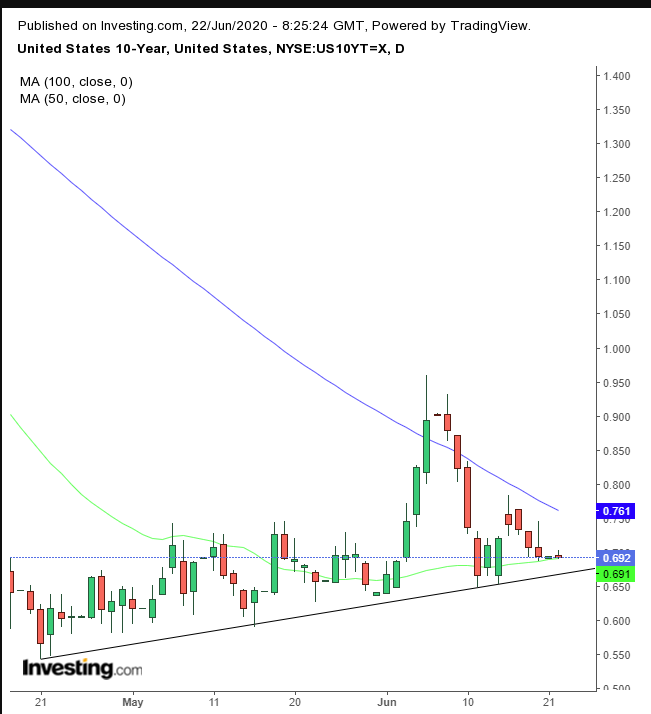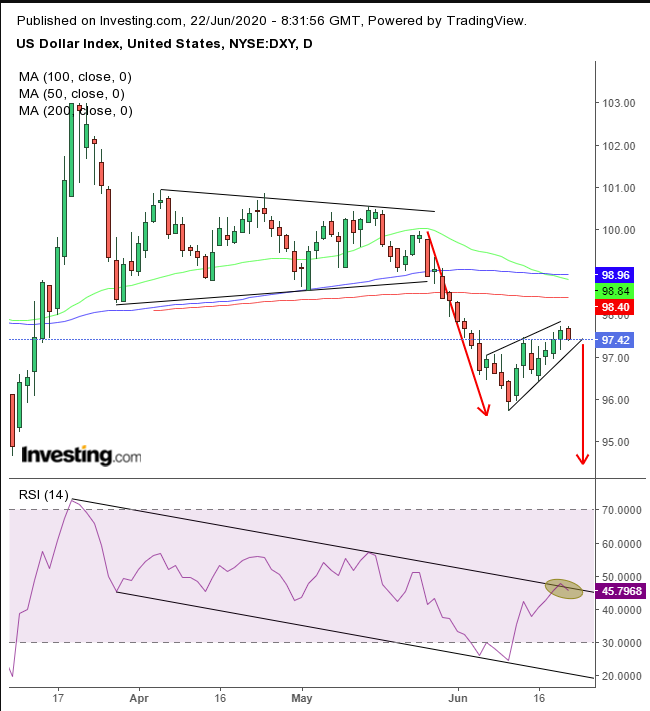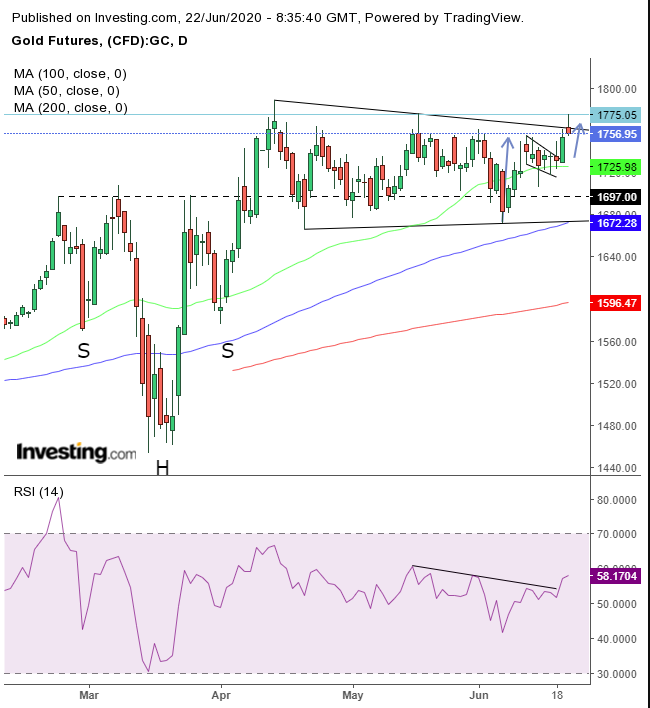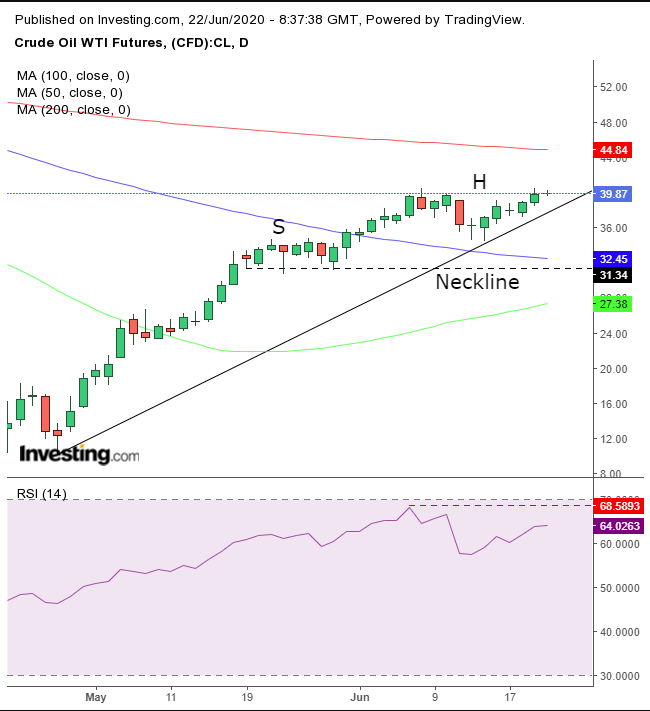- US contracts, stocks fell at the open, but then pushed higher
- WHO reported biggest single-day surge for COVID-19 cases over the weekend
- Gold flirted with a 7-year high
- On Tuesday, investment analytics and index company MSCI Inc. (NYSE:MSCI) announces its market classification review for 2020.
- The IMF will release new 2020 growth projections on Wednesday.
- US Initial Jobless Claims, Durable Goods Orders and GDP data are all due out Thursday.
- A rebalance of Russell indices is expected on Friday.
- Futures on the S&P 500 Index gained 0.5%.
- The Stoxx Europe 600 Index advanced 0.6%.
- The U.K.’s FTSE 100 fell 0.8%.
- The MSCI Asia Pacific Index increased 0.2%.
- The MSCI Emerging Markets Index climbed 0.6% to 1,001.36.
- The Dollar Index slipped 0.2% to 97.42.
- The euro rose 0.2% to $1.1196.
- The British pound jumped 0.3% to $1.2386.
- The onshore yuan fell 0.1% to 7.079 per dollar.
- The Japanese yen weakened 0.1% to 106.95 per dollar.
- The yield on 10-year Treasuries dipped less than one basis point to 0.69%.
- The yield on two-year Treasuries gained less than one basis point to 0.19%.
- Germany’s 10-year yield fell one basis point to -0.42%.
- Britain’s 10-year yield jumped one basis point to 0.238%.
- Japan’s 10-year yield sank one basis point to 0.01%.
- West Texas Intermediate crude fell 0.6% to $39.53 a barrel.
- Brent crude gained 0.2% to $42.29 a barrel.
- Gold strengthened 0.2% to $1,747.87 an ounce.
Key Events
Contracts on the four main US indices—for the Dow Jones, S&P 500, Russell 2000 and the NASDAQ—opened lower on Monday, though at the time of writing they've all reversed into positive territory. As well, the NASDAQ's gap closed.
Treasury demand increased and the dollar fell as gold headed higher.
Global Financial Affairs
The World Health Organization reported the biggest one-day jump in COVID-19 cases over the weekend, with more than 183,000 new cases worldwide. Over 30,000 of those occurred in the US, which actually hit that number two days in a row, on Friday and Saturday, the largest daily increase in the viral outbreak since May 1. On Saturday, seven states reported new record numbers. Moreover, Florida and South Carolina posted three straight days of single-day records.
This morning, European shares are struggling, pressured by the negative news across the region. The coronavirus outbreak rate in Germany jumped for a second day, spiking at a 60% increase in just 24 hours. Spain, one of the worst affected countries on the Continent, reopened its borders, which have been shut for 14 weeks, even as a second wave appears to be accelerating.
The STOXX Europe 600 Index fell at the open, dragged lower by a variety of high-profile stocks: Wirecard (DE:WDIG), the German fintech company currently beset by a scandal that includes 1.9 billion euro ($2.1 billion) of company funds gone missing; Lufthansa (DE:LHAG), which is facing a dramatic week as the state negotiates bailout terms for the German airline; and commodity miner and trader Glencore (LON:GLEN), now the subject of a Swiss criminal investigation on suspicion of corruption in the Democratic Republic of the Congo.
Earlier today, most Asian benchmarks finished lower on increased volatility, as confused traders sought direction when China and South Korea both reported a reduction in COVID-19 cases, while the pandemic hit records in other parts of the world.
South Korea’s KOSPI underperformed, (-0.7%), on disappointing export data and fears of a second wave, even as it reports lower virus numbers. Australia’s ASX 200, (+0.03%), was the only major regional index in the green, though just barely.
Still, the session wasn’t completely risk-off. Safe haven assets were not necessarily rising.
The yield on the 10-year Treasury retreated slightly, after initially advancing, even as equites and US contracts were being sold off.

Technically, yields were squeezed between the 100 and 50 DMAs.
The dollar fell, despite the increased demand for Treasurys, perhaps on foreign repatriation.

Technically, the dollar has been trading along a rising flag, bearish after the 4% selloff, from May 25-June 13. The RSI found resistance at the top of its falling channel, suggesting prices may follow momentum lower.
The USD, which has recently had something of a wild ride, strengthened against the yen, even though investors have been unwinding positions in equities and US futures.
Gold touched a 7.5 year-high.

The precious metal temporarily reached its highest level since October 2012, but retreated into a symmetrical triangle. If the yellow metal closes at this price or a little lower it will have formed a shooting star, whose bearish sentiment would be compounded by the resistance of the top of the pattern.
This is the return-fire by bears amid a bullish uprising, to break out of a presumptively bullish pattern. The RSI has already made such a breakout. Gold could be heading toward $1800, or even higher.
Oil is flat, lingering below the psychologically significant $40 level.

WTI is keeping in play the makings of a H&S top. The RSI provided a negative divergence, bolstering a bearish scenario.
